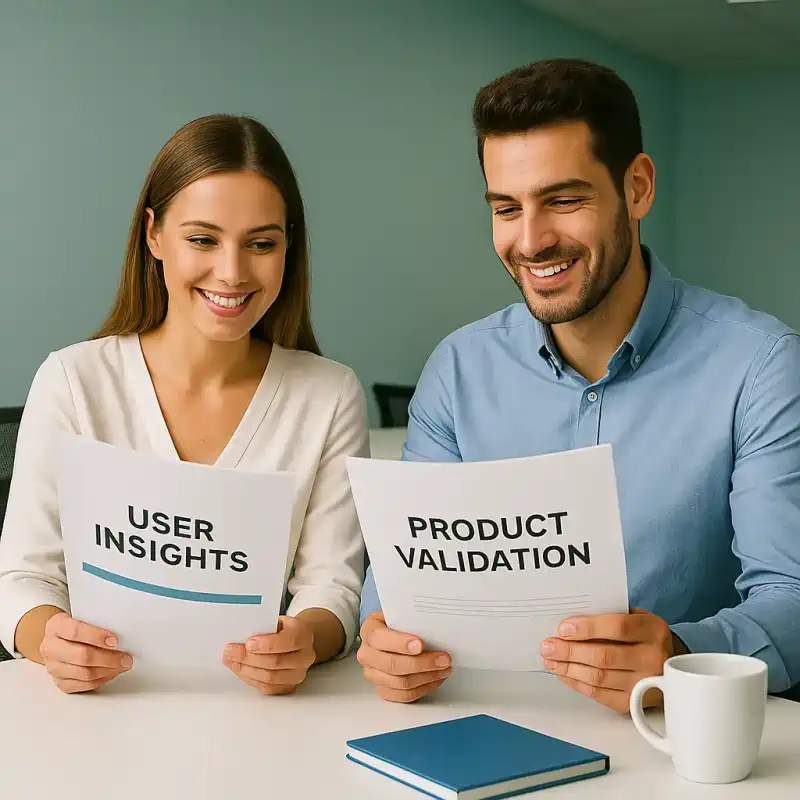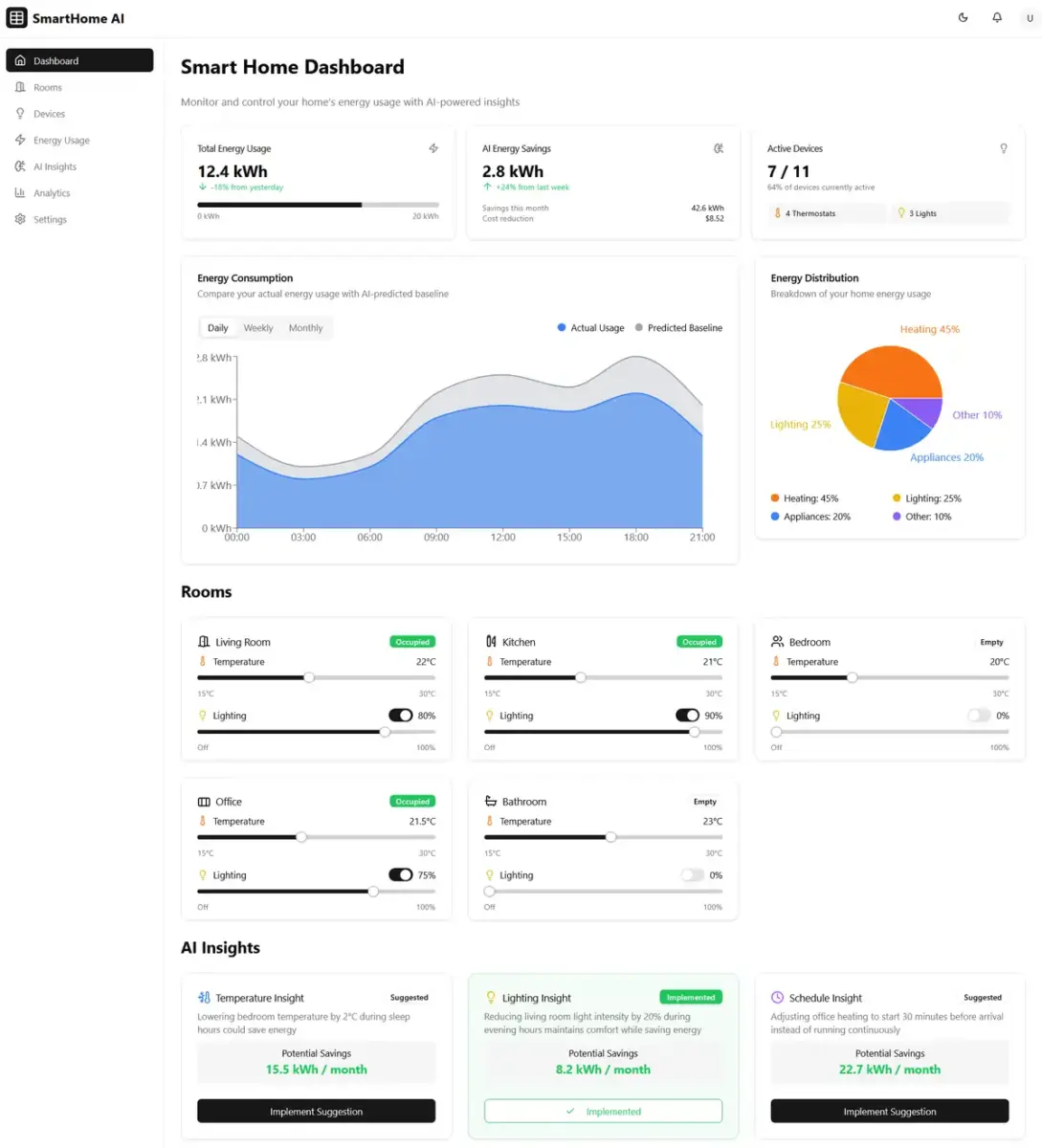Solutions
MVP Development
We specialize in minimum viable product (MVP) development and product validation, helping you bring your product ideas to life efficiently, validate your key value proposition with certainty, and accelerate your path to product-market-fit.

Your experts for MVP development
MVP Solutions
MVP Build
Product idea analysis covering value proposition, target audience, learning objectives, and selection of the right MVP type, subsequenlty a rapid MVP build ready for validation.
MVP Validation
Data collection and user insight analysis to measure the success of learning objectives and ultimately determine the product idea’s potential for success.
MVP Build
Product development can be a tricky endeavor, especially when the proposed solution is new, or the market situation is unclear. Months or years of development are time-consuming and costly, and there will still be uncertainty about the desired success of the product once it is technically developed. Therefore, using an MVP is a great way to assess the viability of a product idea by building prototype-like embodiments of the idea and validating them with reliable data insights to improve, pivot, or even cancel the project. With MVPs specifically tailored to your value proposition and target audience, you can gain valuable early-stage insights to predict product success, while keeping effort and costs low and ultimately reducing time-to-market.
-
 Services
ServicesOur MVP services begin with the analysis of your product idea, distilling the value proposition and the target audience. We help you identify key assumptions and risks that should be assessed as early as possible. We recommend an appropriate MVP type and validation methodology, and finally, we rapidly build your MVP.
Product Idea Analysis: Understanding your product vision and key objectives is the starting point for the product idea analysis, where we work with you to define the primary target audience and core value proposition to validate.
Product Strategy: We help you develop a robust product strategy, identifying critical risks and high-value features that should be clarified in the early stages with MVPs. Based on the specifics of the target audience and value proposition, we recommend an appropriate type of MVP, and the analysis to be performed to provide reliable insights to achieve the learning objective.
MVP Build: Once the MVP type and learning objectives are clarified, we design and develop the MVP using efficient technologies and platforms such as no-/low-code to reduce development time and finalize the MVP as soon as possible so that it is ready for validation.
MVP Validation
While mockups and prototypes are great for clarifying feasibility and getting an idea of how the final product might look like, validating a product strategy requires much more. MVP validation is about testing how the market responds to the value proposition, which could be an internal department of your organization or the general public with a large user base, depending on the defined target audience. To make a data-driven decision, the right, sufficient, and reliable data must be collected and analyzed.
-
 Services
ServicesMVP validation requires a defined product strategy and an MVP to be validated. Validation begins with planning what data to collect, how to collect that data, and what insights to derive from that data. After execution, the collected data is analyzed, and the learning objective is evaluated. This leads to a decision for another MVP iteration or the end of the validation phase.

Validation Planning: A good validation plan is the key to success. Even when the product strategy is defined and the right MVP type is selected and built, it is the details that lead to insightful results. With the learning objective as the primary goal, appropriate metrics are defined that match the MVP type. These metrics are used to identify the data that needs to be collected, both in terms of type and volume. Metrics can be as simple as click-through rates on a landing page or as advanced as user behavior analysis, observations, and interviews. The planned effort and duration are highly dependent on the learning objective and MVP type.
Test Execution: There are different levels of test execution, ranging from simple automation of data collection and analysis to highly personalized user interviews. At the end of this stage, the data required to gain the insights defined in the product strategy and validation plan is available for analysis and decision making.
Insight Analysis: With the raw data collected, subsequent data analysis leads to the identification of metrics that are key to understanding the MVP’s performance against learning objectives. Expectations and assumptions previously stated in the product strategy are reviewed and updated. At this point, there is enough information to make a decision to either create a follow-up MVP with new learning objectives or to initiate the development of the final product.
Have a project idea in mind?
Let’s find out how we can help you turn your vision into reality!
Frequently Asked Questions (FAQ)
When should an MVP build be considered?
Building an MVP is appropriate when you want to validate a product idea quickly and efficiently with limited resources and time. This approach is particularly useful in the early stages of development, when the primary goal is to demonstrate the core value proposition to potential users. MVPs are ideal for projects with a medium to high risk of failure due to factors such as the novelty of the solution or unclear market conditions. By focusing on key features and gathering user feedback, MVPs help identify potential problems and opportunities early on, allowing for informed decision-making and iterative improvements. This process ultimately increases the likelihood of a product-market-fit and ensures that the final product meets real business needs and user expectations.
What types of MVPs exist?
There are several common types of MVPs, each serving a different purpose. A landing page MVP involves creating a simple web page that describes the product idea and gathers user interest through signups or other interactions. This type of MVP helps gauge initial interest without having to build the actual product.
An email campaign MVP works similarly, using email campaigns to describe the product idea and gather feedback from potential users.
A concierge MVP involves manually delivering the service to a small group of users to validate the concept before automating it. This approach allows for direct interaction and feedback to ensure that the product meets user needs.
The Wizard of Oz MVP is another type where users interact with what appears to be a fully functional product, but behind the scenes processes are handled manually. This method tests user interest without full development.
The Piecemeal MVP combines existing tools and services, such as automation, to create a functional product prototype. This approach leverages existing solutions to validate the product idea quickly and efficiently.
Finally, the Single-Feature MVP focuses on developing only the core feature of the product to test its viability and gather user feedback. Each type of MVP serves to validate different aspects of the product idea, helping to refine and improve the final product.
What are the benefits of an MVP validation for the final product development?
MVP validation provides several significant benefits to final product development. By validating the product strategy through user feedback and data analysis, it massively reduces uncertainty and provides a more precise specification for the development process. This ensures that the final product is better aligned with market needs and user expectations. In addition, critical issues identified during MVP development can be addressed early in the final product, increasing its robustness and relevance. The insights gained from MVP validation help refine the product, mitigate risk, and increase the likelihood of achieving product-market-fit, ultimately leading to a successful and well-received product.
